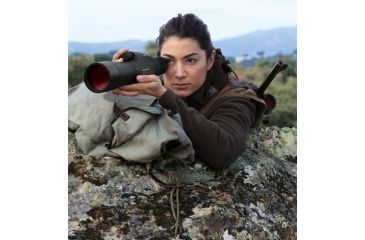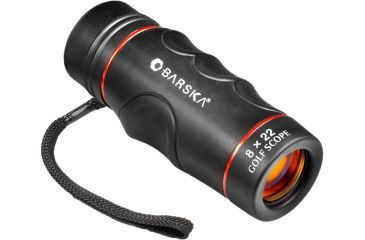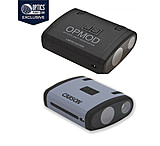A monocular is a miniature, low powered telescope or spotting scope which you hold in your hand like a binocular but use with one eye like a telescope. A monocular shares characteristics with both binoculars and spotting scopes, but is much smaller than either. Size, then, is really what a monocular is all about. Some monoculars are no larger than your thumb or thicker than a good ink pen and any monocular will slip easily into a pocket or a purse. When a spotting scope or a pair of binoculars is too large to take along, there is always a monocular. There is no excuse for leaving home without one if you're heading out into the woods.![]()
A good time to consider buying a monocular is anytime you need to keep things small when you're exploring. Is that a rock or a deer out in that field? Pull a monocular out of your pocket and take a look. What does that sign across the shopping center say? Pull a monocular out of your purse or pocket and take a look. A monocular can also do double duty as a magnifier. Some actually have a very close focus, but turn any magnifier over, hold it over an object and you have a magnifier.
When Should You Choose a Monocular?
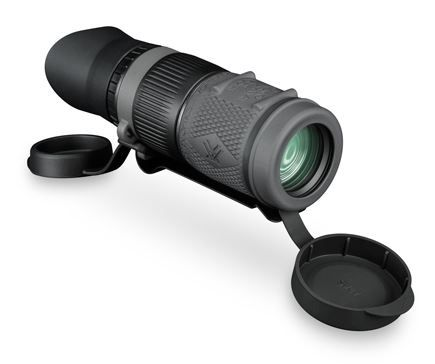 When should you choose binoculars instead of a monocular? If you need to take a long look or scan an area, go with a binocular. Using two eyes, as with a binocular, produces less eyestrain than using one eye. Plus, your depth perception and visual acuity are better when using two eyes. For this reason, a monocular is not a substitute for a binocular when the action turns serious. For birding, hunting, surveillance, astronomy and other involved applications, a binocular is always a better performer. The whole idea of a monocular, though, is to have something at hand when you would not ordinarily carry binoculars. I've seen and recorded a great number of birds simply because I happened to have my monocular in my purse.
When should you choose binoculars instead of a monocular? If you need to take a long look or scan an area, go with a binocular. Using two eyes, as with a binocular, produces less eyestrain than using one eye. Plus, your depth perception and visual acuity are better when using two eyes. For this reason, a monocular is not a substitute for a binocular when the action turns serious. For birding, hunting, surveillance, astronomy and other involved applications, a binocular is always a better performer. The whole idea of a monocular, though, is to have something at hand when you would not ordinarily carry binoculars. I've seen and recorded a great number of birds simply because I happened to have my monocular in my purse.
When should you choose a spotting scope, instead of a monocular? Anytime you need more magnification than you can get with a binocular or monocular, go with a spotting scope. A spotting scope may, in principle, seem to be nothing more than a very large monocular, but in truth; a spotting scope and a monocular are very different beasts. A spotting scope is large and heavy and, because of its very high magnification, it must be mounted on a tripod for steadiness. That's about as far from a monocular as you can get.
What Do Magnification and Objective Sizes Mean?
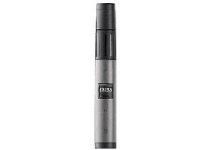 Magnification is the first number when listing the specs of the device, such as the 6 in 6x15. This refers to how many times the image is enlarged over normal. More might seem better, but with any optical instrument, the higher the magnification, the harder the instrument is to use. This is especially true in a small, lightweight instrument like a monocular. A magnification of 5x or 6x is a very practical magnification for a monocular. It will be easy to steady and have a wide field of view to help you locate the target. A magnification of 8x will be significantly harder to steady and have a narrower field of view, while 10x is even harder to use. There are even zoom monoculars, but these are often not as durable as fixed power models.
Magnification is the first number when listing the specs of the device, such as the 6 in 6x15. This refers to how many times the image is enlarged over normal. More might seem better, but with any optical instrument, the higher the magnification, the harder the instrument is to use. This is especially true in a small, lightweight instrument like a monocular. A magnification of 5x or 6x is a very practical magnification for a monocular. It will be easy to steady and have a wide field of view to help you locate the target. A magnification of 8x will be significantly harder to steady and have a narrower field of view, while 10x is even harder to use. There are even zoom monoculars, but these are often not as durable as fixed power models.
Objective size is the second number in the listing, which in the previous example is 15. This refers to the size of the front lens in millimeters. With all other factors being equal, the larger the objective lens, the better the optical performance. However, bigger is not necessarily better. The bigger the lens, the bigger and heavier the monocular. A 10x40 monocular will be roughly about half of a full size binocular. A 5x15 will be no larger than your thumb. In terms of performance, optical quality is actually more important than objective lens size. In fact, you can have an optically excellent monocular that is also very small, if you are willing to pay the price.
Eye Relief, Field of View, Lens Coatings, & More
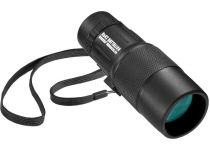 Field of view is the amount of territory you see when you look through the monocular. Imagine a fence 1000 yards away. If a monocular has a field of view of 372 feet at 1000 yards, you will see 372 feet of the fence. If the field of view is 250 feet at 1000 yards, you will see 250 feet of fence. A basic law of optics is that as magnification goes up, your field of view goes down. If you want a wide field of view, keep the magnification down.
Field of view is the amount of territory you see when you look through the monocular. Imagine a fence 1000 yards away. If a monocular has a field of view of 372 feet at 1000 yards, you will see 372 feet of the fence. If the field of view is 250 feet at 1000 yards, you will see 250 feet of fence. A basic law of optics is that as magnification goes up, your field of view goes down. If you want a wide field of view, keep the magnification down.
Eye relief is the distance your eye can be from the eyepiece and still see the entire field of view. It is measured in millimeters. If you wear glasses when you observe, this is a critical feature, because you glasses won't allow you to get your eye close to the eyepiece. If you wear glasses, look for a model that lists at least 14mm of eye relief.
Close focus is the minimum distance at which a monocular will focus on an object. The close focus on some models is actually measured in inches, instead of yards, making these close focus models very versatile. There is nothing quite as spectacular as viewing a butterfly perched a few feet away through a good monocular.
Lens coatings affect image brightness. The best monoculars are labeled as fully multi-coated, followed by multi-coated, then fully coated. Additionally, look for a waterproof monocular if you are in a boat, around water, or in a wet climate. This ensures you protect the sensitive coatings and technology in the device.
Grab a Brand New Monocular Today!
Here at OpticsPlanet, we strive to bring you everything you could need for any adventure. If you're looking for high-quality red dot sights, rifle scopes, or any other optic, we stock thousands of options from all the best brands. And, to help you save as much money as possible on your order, we provide Free Shipping on most purchases over $49!
